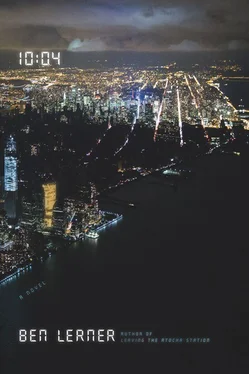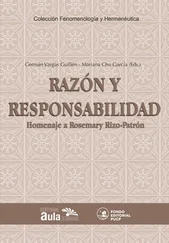Ben Lerner
10:04: A Novel
The Hassidim tell a story about the world to come that says everything there will be just as it is here. Just as our room is now, so it will be in the world to come; where our baby sleeps now, there too it will sleep in the other world. And the clothes we wear in this world, those too we will wear there. Everything will be as it is now, just a little different.
The city had converted an elevated length of abandoned railway spur into an aerial greenway and the agent and I were walking south along it in the unseasonable warmth after an outrageously expensive celebratory meal in Chelsea that included baby octopuses the chef had literally massaged to death. We had ingested the impossibly tender things entire, the first intact head I had ever consumed, let alone of an animal that decorates its lair, has been observed at complicated play. We walked south among the dimly gleaming disused rails and carefully placed stands of sumac and smoke bush until we reached that part of the High Line where a cut has been made into the deck and wooden steps descend several layers below the structure; the lowest level is fitted with upright windows overlooking Tenth Avenue to form a kind of amphitheater where you can sit and watch the traffic. We sat and watched the traffic and I am kidding and I am not kidding when I say that I intuited an alien intelligence, felt subject to a succession of images, sensations, memories, and affects that did not, properly speaking, belong to me: the ability to perceive polarized light; a conflation of taste and touch as salt was rubbed into the suction cups; a terror localized in my extremities, bypassing the brain completely. I was saying these things out loud to the agent, who was inhaling and exhaling smoke, and we were laughing.
A few months before, the agent had e-mailed me that she believed I could get a “strong six-figure” advance based on a story of mine that had appeared in The New Yorker ; all I had to do was promise to turn it into a novel. I managed to draft an earnest if indefinite proposal and soon there was a competitive auction among the major New York houses and we were eating cephalopods in what would become the opening scene. “How exactly will you expand the story?” she’d asked, far look in her eyes because she was calculating tip.
“I’ll project myself into several futures simultaneously,” I should have said, “a minor tremor in my hand; I’ll work my way from irony to sincerity in the sinking city, a would-be Whitman of the vulnerable grid.”
* * *
A giant octopus was painted on the wall of the room where I’d been sent the previous September for evaluation — an octopus and starfish and various gill-bearing aquatic craniate animals — for this was the pediatric wing and the sea scene was intended to calm and distract the children from needles or the small hammers testing reflex amplitude. I was there at the age of thirty-three because a doctor had discovered incidentally an entirely asymptomatic and potentially aneurysmal dilation of my aortic root that required close monitoring and probable surgical intervention and the most common explanation of such a condition at such an age is Marfan, a genetic disorder of the connective tissue that typically produces the long-limbed and flexible. When I met with a cardiologist and he suggested the evaluation I’d noted my excess proportion of body fat and conventional arm span and only slightly above average height, but he counter-noted my long, thin toes and mild double-jointedness and contended that I might well fall on the diagnostic spectrum. Most Marfanoids are diagnosed in early childhood, thus the pediatric wing.
If I had Marfan, the cardiologist had explained, the threshold of surgical intervention was lower (when the diameter of the aortic root reached 4.5 centimeters), was basically nigh (I was at 4.2 centimeters according to an MRI), because the likelihood of what they call “dissection,” a most often fatal tearing of the aorta, is higher among Marfanoids; if I did not have an underlying genetic condition, if my aorta was deemed idiopathic, I would still probably require eventual surgery, but with a more distant threshold (5 centimeters), and the possibility of much slower progression. In either case, I was now burdened with the awareness that there was a statistically significant chance the largest artery in my body would rupture at any moment — an event I visualized, however incorrectly, as a whipping hose spraying blood into my blood; before collapse a far look comes into my eyes as though, etc.
There I was at Mount Sinai Hospital underwater in a red plastic chair designed for a kindergartner, a chair that had the immediate effect of making me feel ungainly, gangly in my paper gown, and thus confirming the disorder before the team of evaluators arrived. Alex, who had accompanied me for what she called moral support but was in fact practical support, as I had proved unable to leave a doctor’s office with even the most basic recollection of whatever information had been imparted to me there, sat across from me in the lone adult chair, no doubt placed there for a parent, notebook open in her lap.
I’d been told in advance that the evaluation would be conducted by a trio of doctors that would then consult and offer its opinion, which I thought of as a verdict, but there were two things about the doctors now entering with bright smiles that I was not prepared for: they were beautiful and they were younger than I. It was fortunate Alex was present because she would not have otherwise believed me that the doctors — all of whom appeared to be originally from subcontinental Asia — were themselves ideally proportioned in their white coats, with flawlessly symmetrical, high-boned faces that, no doubt through some deft application of shadow and gloss, glowed with almost parodic health even in hospital light, a dusky gold. I looked at Alex, who raised her eyebrows back at me.
They asked me to stand and proceeded to calculate the length of my arms and the curvature of my chest and spine and the arch of my feet, to perform so many measurements according to a nosological program mysterious to me that I felt as if my limbs had multiplied. That they were younger than I constituted an unfortunate milestone beyond which medical science could no longer stand in benevolent paternal relation to my body because such doctors would now see in my pathologized corpus their own future decline and not their past immaturity. And yet in this room outfitted for children I was simultaneously infantilized by three improbably attractive women in their mid- to late twenties while from the more than literal distance of her chair Alex looked on sympathetically.
It can taste what it touches, but has poor proprioception, the brain unable to determine the position of its body in the current, particularly my arms, and the privileging of flexibility over proprioceptive inputs means it lacks stereognosis, the capacity to form a mental image of the overall shape of what I touch: it can detect local texture variations, but cannot integrate that information into a larger picture, cannot read the realistic fiction the world appears to be. What I mean is that my parts were coming to possess a terrible neurological autonomy not only spatial but temporal, my future collapsing in upon me as each contraction expanded, however infinitesimally, the overly flexible tubing of my heart. Including myself, I was older and younger than everyone in the room.
* * *
Her support was moral and practical but also self-interested in that Alex had recently proposed impregnating herself with my sperm, not, she was at immediate pains to make clear, in copula, but rather through intrauterine insemination because, as she put it, “fucking you would be bizarre.” The subject was broached at the Metropolitan Museum, which we often visited weekday afternoons, since Alex was unemployed, and I, a writer.
Читать дальше










